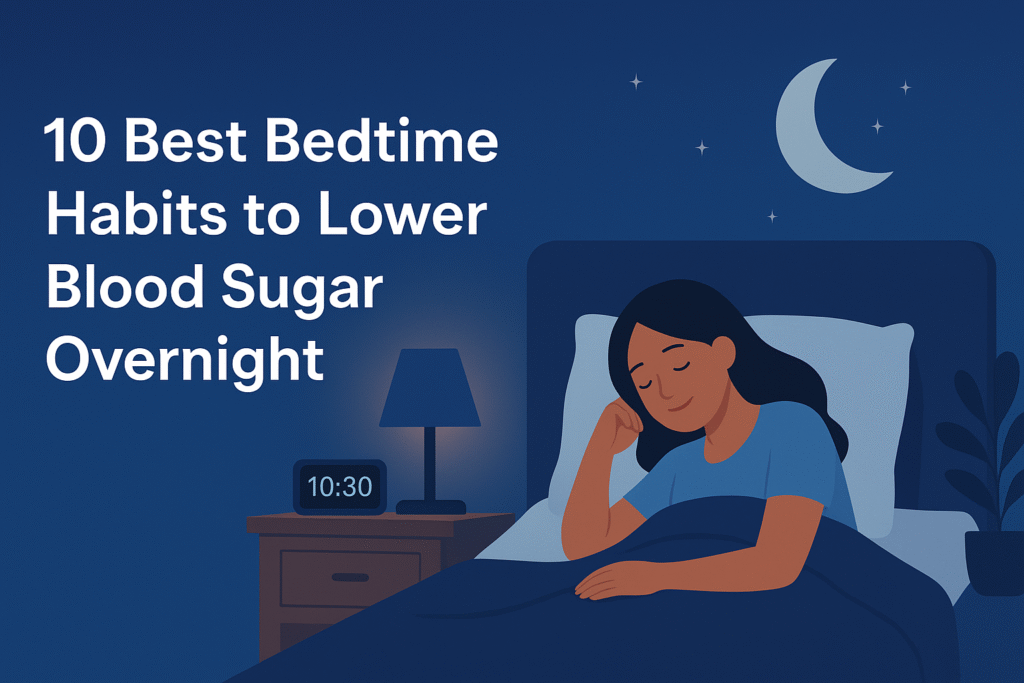
⚠️ Affiliate Disclaimer: This post may contain affiliate links, which means I may earn a small commission — at no extra cost to you — if you make a purchase through one of these links. I only recommend products or services I genuinely trust and believe can provide value. Thank you for supporting My Medical Muse!
10 Best Bedtime Habits to Lower Blood Sugar Overnight
Understanding Why Blood Sugar Rises Overnight
Before diving into the bedtime strategies, it’s important to understand why blood sugar often rises while you sleep, even if you didn’t overeat or snack late. This phenomenon can surprise many people trying to manage their glucose levels.
The Dawn Phenomenon
Between 2 a.m. and 8 a.m., your body naturally releases hormones like cortisol, growth hormone, and glucagon to prepare for the day ahead. These hormones signal your liver to release stored glucose for energy.
If your insulin sensitivity is reduced as in prediabetes or diabetes, this can lead to a morning glucose spike (often called “dawn effect”) even without food intake.
Overactive Liver Glucose Production
Your liver plays a central role in nighttime glucose balance. When it releases too much glucose, perhaps due to stress hormones or a late meal, blood sugar levels rise during the night and may remain high by morning.
Late-Night Snacking or Heavy Dinners
Eating a large or carb-heavy meal close to bedtime can overload your digestive system. While you sleep, your body continues processing that food, and if insulin isn’t keeping up, glucose levels remain elevated into the night.
Poor Sleep Quality
Sleep deprivation and poor sleep patterns disrupt insulin regulation and increase cortisol, a stress hormone that promotes glucose release. Even one night of poor sleep can make your body more insulin resistant the next day.
Understanding these mechanisms helps you make smarter bedtime choices to keep blood sugar stable overnight.
1. Eat a Balanced, Early Dinner
Timing truly matters. Eating too close to bedtime doesn’t allow your body enough time to metabolize glucose efficiently, which may lead to elevated morning readings. Ideally, finish dinner at least 3 hours before you sleep to allow digestion and insulin action to complete before rest.
What to Do
- Eat your largest meal earlier in the evening, ideally before 7 p.m.
- Prioritize lean proteins (like fish, chicken, tofu, or eggs) and non-starchy vegetables (such as spinach, zucchini, or broccoli) to slow glucose absorption.
- Include healthy fats, olive oil, avocado, chia seeds, or nuts to enhance satiety and maintain balanced energy levels.
- Keep carbohydrates moderate and complex, think quinoa, lentils, barley, or a small portion of sweet potato.
This combination promotes steady glucose release, prevents overnight spikes, and supports restful sleep.
Example Dinner:
Grilled salmon, steamed broccoli, a small portion of quinoa, olive oil dressing.
This balanced meal supports a slow, sustained glucose release helping your body maintain equilibrium through the night.
2. Have a Blood-Sugar-Friendly Bedtime Snack (If Needed)
For some people, especially those using insulin or glucose-lowering medications, going to bed on an empty stomach can lead to overnight hypoglycemia (low blood sugar). In such cases, a light, nutrient-dense bedtime snack helps maintain steady glucose levels throughout the night.
Conversely, others might find that even a small snack can cause mild elevations if poorly chosen. The key is to find your personal balance, a snack that prevents drops without causing spikes.
Best Nighttime Snacks
- A handful of almonds or walnuts (healthy fats and protein).
- Greek yogurt sprinkled with chia seeds (slow-digesting protein and fiber).
- Cottage cheese with a few fresh berries (low glycemic and rich in casein protein).
- Apple slices with peanut butter (natural carbs balanced by healthy fat).
Avoid sugary or refined-carb options like cookies, pastries, fruit juice, or breakfast cereal. These cause a quick rise followed by a crash, which can disrupt both your sleep and blood sugar stability.
If you’re unsure whether a snack helps or hurts your levels, try tracking your glucose with a Continuous Glucose Monitor (CGM) for a week. This data will reveal your individual response, some people find a small protein-fat combo stabilizes them, while others do best without a snack at all.
3. Manage Evening Stress to Lower Cortisol
Stress management isn’t just about peace of mind, it’s a direct lever for blood sugar control. Elevated cortisol, your body’s primary stress hormone, stimulates glucose release from the liver and reduces insulin sensitivity. When cortisol levels remain high into the evening, your blood sugar tends to rise and stay elevated overnight.
Why It Matters
Cortisol naturally follows a daily rhythm, higher in the morning and lower at night but chronic stress, emotional tension, or even late-night work can disrupt this pattern, keeping your body in a “fight-or-flight” mode when it should be winding down.
Relaxation Strategies
Before bed, aim to activate your parasympathetic nervous system, the “rest and digest” mode to help your body naturally lower glucose levels.
Try one or more of these calming routines:
- Practice 10-15 minutes of meditation or deep breathing before bed to signal relaxation.
- Write in a gratitude journal, this simple reflection helps reduce anxious thoughts.
- Listen to soft music or guided sleep sounds, ideally instrumental or nature-based.
- Avoid doomscrolling, news, or intense conversations in the hour before bedtime.
Studies on Mindfulness-Based Stress Reduction (MBSR) have shown significant reductions in fasting glucose and HbA1c among individuals with type 2 diabetes. This proves that mental calm isn’t just soothing, it’s physiologically healing.
4. Stay Hydrated But Time It Right
Hydration plays a subtle yet powerful role in glucose balance. When you’re even mildly dehydrated, your blood becomes more concentrated, making glucose levels appear higher. Proper hydration helps your kidneys flush excess sugar and maintain optimal metabolic flow.
Smart Hydration Tips
- Drink water consistently throughout the day instead of chugging large amounts at once.
- Have your final glass of water 1-2 hours before bed, enough to stay hydrated without waking up multiple times to use the bathroom.
- Avoid sugary drinks, alcohol, or soda at night. These beverages can spike glucose and interfere with sleep quality.
- Add a pinch of sea salt or electrolytes if you sweat heavily during the day, this helps maintain fluid balance and supports glucose metabolism.
Warm water or caffeine-free herbal teas (like chamomile or cinnamon tea) can be a soothing pre-bed ritual that supports both relaxation and hydration.
5. Prioritize Quality Sleep
Sleep is one of the most overlooked pillars of glucose control. Even one restless night can elevate blood sugar the next day by increasing insulin resistance and cortisol production.
A 2022 meta-analysis found that a single night of sleep deprivation can make your cells up to 30% less responsive to insulin the following day. This means your body needs more insulin to move the same amount of glucose, setting you up for higher morning readings.
Sleep Tips for Glucose Balance
- Aim for 7-9 hours of restful, uninterrupted sleep each night.
- Keep your bedroom cool (around 65-68°F or 18-20°C) and dark.
- Use blackout curtains or a sleep mask to block artificial light.
- Go to bed and wake up at consistent times, your metabolism loves rhythm.
- Avoid caffeine after 2 p.m. and heavy meals within 3 hours of sleep.
- If you snore or wake up gasping, consider a sleep study for sleep apnea. Treating it can dramatically improve insulin sensitivity and overnight glucose regulation.
If stress or screen time delays your sleep, try dimming your lights and using “night mode” on devices 1-2 hours before bed to promote melatonin release.
6. Take a Short Evening Walk
Few habits are as simple yet as effective as a light post-dinner walk. Gentle movement helps your muscles absorb glucose directly from the bloodstream, reducing dependence on insulin.
After eating, glucose enters your bloodstream. Walking activates your large muscle groups, which draw in glucose for energy, lowering your levels naturally. Even 10-20 minutes of activity can make a measurable difference in post-meal glucose curves.
Benefits
- Reduces post-dinner glucose and insulin spikes.
- Improves digestion and circulation.
- Promotes relaxation and helps signal your body it’s time to wind down.
If you can’t go outdoors, no problem. Try gentle indoor movement pacing around the house, stretching, yoga flows, or even light dancing to calming music. The key is to move your body gently, not vigorously, to avoid raising your heart rate too much before bedtime. Pair your walk with gratitude reflections or quiet time instead of scrolling on your phone, it doubles the relaxation benefit.
7. Keep Your Bedroom Cool and Dark
Your sleep environment doesn’t just influence comfort, it directly impacts metabolic health. Studies show that sleeping in a cooler room (around 65°F / 18°C) can improve insulin sensitivity and increase brown fat activity, a type of fat that burns glucose for heat.
What to Try
- Lower the thermostat slightly before bed or use a fan for air circulation.
- Eliminate light sources, close curtains, cover LEDs, and dim electronics.
- Avoid bright screens (phones, TVs, or tablets) 30-60 minutes before bedtime.
- Consider white noise or soft ambient sounds if your environment is noisy.
A dark, cool, and quiet room encourages the release of melatonin, your natural sleep hormone. Beyond regulating circadian rhythm, melatonin also plays a supportive role in glucose metabolism by improving nighttime insulin sensitivity.
A 2018 clinical trial published in Diabetes Research and Clinical Practice found that people who slept in cooler environments had significantly lower fasting glucose and improved insulin sensitivity after just four weeks.
8. Check Blood Sugar Before Bed (and Upon Waking)
Knowledge is power when it comes to managing blood sugar, your bedtime and morning readings are two of the most revealing data points. Monitoring these helps you spot trends, identify triggers, and make small, targeted adjustments that lead to better overnight control.
Why It Matters
A bedtime glucose reading above 140 mg/dL (7.8 mmol/L) may indicate that your dinner or evening snack was too high in carbohydrates or simple sugars.
A morning spike (especially after a normal bedtime reading) could signal the dawn phenomenon or late-night liver glucose release.
On the other hand, if your morning glucose is too low, you may be experiencing nocturnal hypoglycemia, especially if you’re taking insulin or sulfonylureas.
How to Use the Data:
Track your readings for at least 7 consecutive nights to identify consistent patterns.
Note what you ate for dinner, how you slept, and any stress or exercise factors.
If your morning readings are frequently high despite good habits, discuss them with your doctor or diabetes educator, small medication timing or dose adjustments can have a big impact.
For greater accuracy, check your fasting glucose right after waking (before breakfast or coffee), even a small delay can cause readings to rise due to morning cortisol release.
9. Review Medications and Timing with Your Doctor
Your medication schedule can either support or sabotage your nighttime glucose control. Many diabetes drugs work in specific rhythms, aligning them properly with your body’s needs ensures steady overnight results.
Common Medication Timing Insights
Metformin: Often prescribed at night to help reduce overnight liver glucose production. Taking it with or after your evening meal may help minimize side effects.
Basal Insulin (e.g., glargine, detemir, degludec): Designed to provide a slow, steady insulin release for 24 hours, basal insulin can help blunt the dawn phenomenon and prevent early-morning spikes.
GLP-1 Agonists (like Ozempic or Rybelsus): Can improve insulin sensitivity and glucose control when used consistently, though timing depends on your prescription and tolerance.
SGLT2 Inhibitors (like Jardiance or Farxiga): Often taken in the morning but may impact overnight glucose stability depending on hydration and diet.
Important: Never change your medication timing or dosage on your own. Always consult your healthcare provider or endocrinologist before making adjustments. Together, you can tailor your regimen to better support your nighttime glucose goals.
Did You Know? Some people find that simply shifting their basal insulin injection by 1-2 hours under medical supervision, dramatically improves fasting glucose consistency.
10. Use Technology to Track Your Progress
Technology has transformed how we understand and manage blood sugar. Today’s tools provide real-time insights into how your meals, movement, and bedtime habits affect your overnight glucose curve.
Recommended Tools
Continuous Glucose Monitors (CGMs): Devices like Dexcom, Freestyle Libre, or Levels continuously track your glucose every few minutes, so you can see exactly when spikes or drops occur overnight.
Smart Rings and Sleep Trackers: Devices such as Oura Ring, Fitbit, or Apple Watch monitor heart rate variability (HRV), sleep stages, and stress, all of which influence glucose balance.
Data Integration Apps: Platforms like MySugr, Glucose Buddy, or Diabetes:M allow you to log meals, workouts, sleep quality, and glucose readings in one place for a holistic view.
When you see a direct correlation, for example that a light evening walk or herbal tea ritual lowers your morning glucose by 10-20 points, motivation skyrockets. These patterns make it easier to fine-tune your habits and build a personalized nighttime routine that truly works.
Review your data weekly instead of daily. Long-term patterns are more meaningful than day-to-day fluctuations.
Support Nighttime Hormones Naturally
Your hormones, melatonin, cortisol, insulin, and growth hormone all work together overnight to regulate metabolism and glucose use. Balancing them naturally can have a profound effect on how your body processes sugar while you sleep.
How to Support Hormonal Balance
Avoid blue light for at least one hour before bed. Blue light suppresses melatonin and increases cortisol, both of which can raise blood sugar.
Eat tryptophan-rich foods such as turkey, eggs, or pumpkin seeds. These help your body produce serotonin and melatonin naturally.
Keep a consistent bedtime and wake-up schedule, even on weekends. Your circadian rhythm is one of your strongest metabolic regulators.
Limit late caffeine or alcohol, which can disrupt hormone release and cause glucose volatility overnight.
Melatonin doesn’t just help you fall asleep, it also enhances cellular glucose uptake and works synergistically with insulin when secreted at healthy nighttime levels.
When to Talk to Your Doctor
Even with consistent healthy habits, some individuals may still experience high fasting glucose. This doesn’t mean you’re doing something wrong, it often signals that deeper physiological factors are at play.
Contact Your Healthcare Provider If:
Your fasting glucose remains above 130 mg/dL (7.2 mmol/L) for more than a week.
You frequently wake up feeling thirsty, fatigued, or with headaches are possible signs of overnight hyperglycemia.
You experience night sweats, shakiness, or vivid dreams, which can indicate nocturnal hypoglycemia.
Your provider may explore:
Insulin resistance progression or medication adjustments.
Sleep apnea or nighttime stress patterns affecting hormones
Hormonal imbalances, such as thyroid or adrenal issues
Early intervention prevents complications such as neuropathy, kidney damage, and cardiovascular strain, keeping your metabolism resilient and your energy steady.
Your nighttime routine is one of the most underrated tools for blood sugar balance. By combining mindful eating, gentle movement, proper hydration, stress relief, and consistent sleep hygiene, you can train your body to maintain stable glucose levels overnight. Small changes, like taking a short walk after dinner, meditating before bed, or dimming your lights can compound over time into powerful metabolic results.
When you wake up with steady energy, clear focus, and balanced glucose, you’ll know your bedtime routine is truly working for you.
Final Thoughts: Small Habits, Big Results
Lowering blood sugar overnight isn’t about drastic measures, it’s about consistency. Your body thrives on predictability: steady meal times, restful sleep, stress control, and gentle movement.
By combining these bedtime habits, you can:
- Improve insulin sensitivity
- Reduce dawn phenomenon
- Sleep better and wake up refreshed
- Protect your long-term metabolic health
Remember, blood sugar management is a 24-hour process and nighttime is one of the most powerful (and often overlooked) opportunities to support your health.
👩⚕️ Need Personalized Health Advice?
Get expert guidance tailored to your unique health concerns through MuseCare Consult. Our licensed doctors are here to help you understand your symptoms, medications, and lab results—confidentially and affordably.
👉 Book a MuseCare Consult NowRelated Blog Post You Might Like:
- Can Dehydration Raise Blood Sugar Levels? 7 Powerful Reasons Why
- 7 Surprising Reasons Why Your Blood Sugar Spikes After Eating Healthy Foods
- 7 Clear Reasons Why Your Blood Sugar Is High in the Morning but Normal Later
- 7 Surprising Reasons Why Your Blood Sugar Spikes After Eating Low-Carb Meals
- Can Dehydration Raise Your Blood Pressure? 10 Powerful Reasons Why
- 10 Proven Benefits of Nutritional Counseling for Diabetes Management


